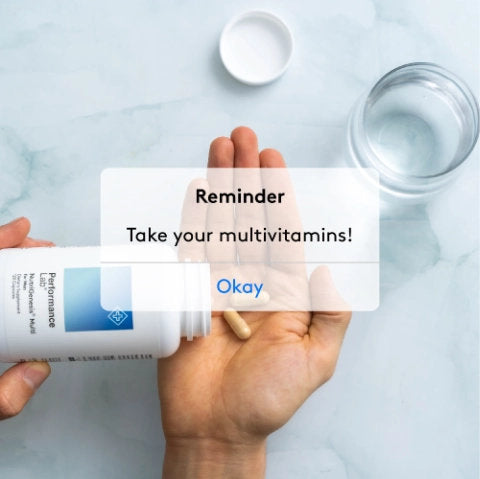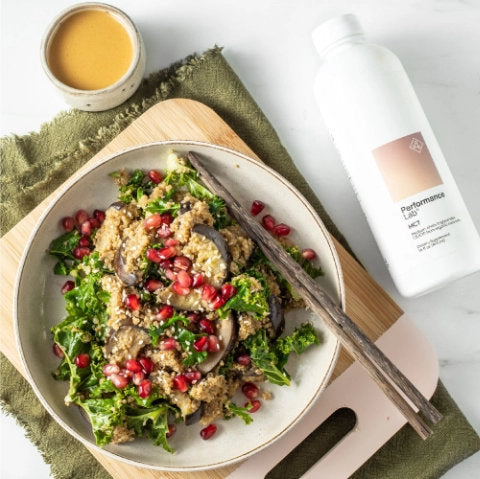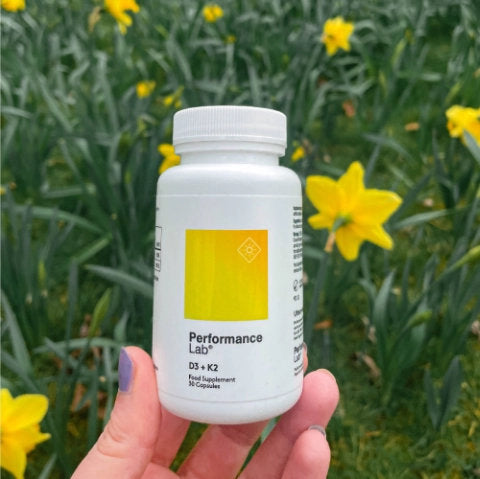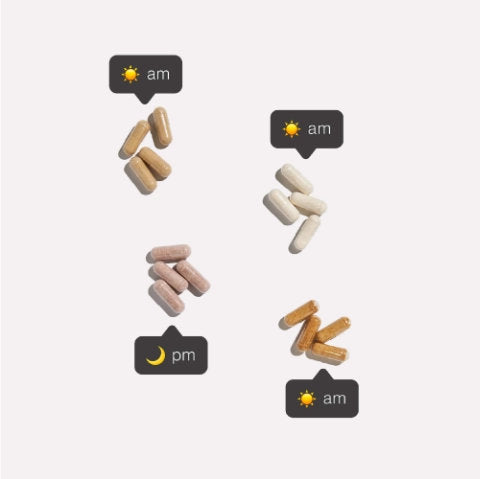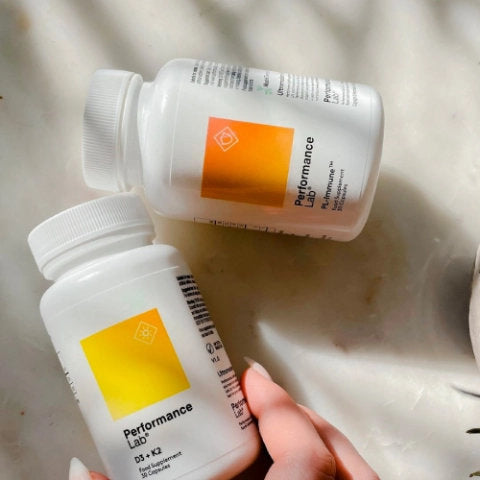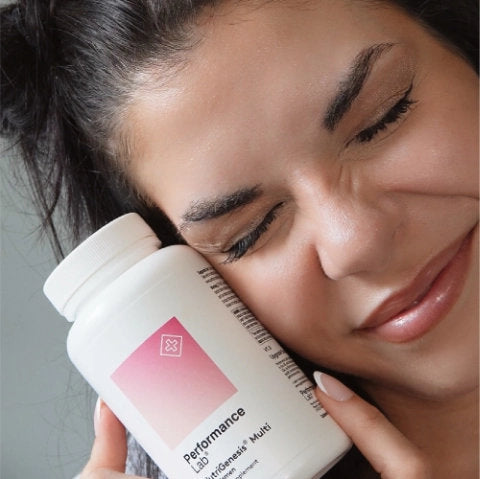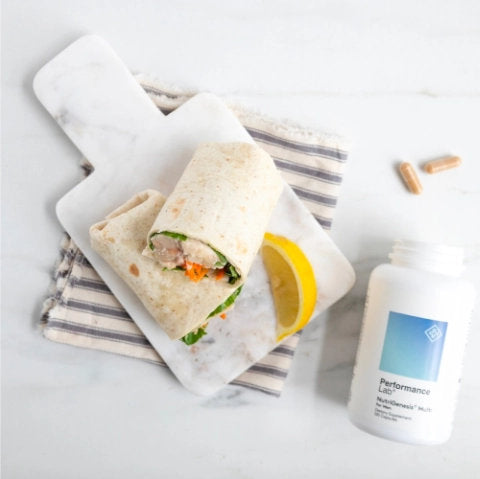Key Takeaways
-
Turmeric (curcumin) and Boswellia serrata are two anti-inflammatory herbs with unique effects on the body. [1, 4]
-
Both are clinically studied for reducing pain and inflammation—including in conditions like arthritis. [6]
-
Curcumin inhibits the COX-2 enzyme and bolsters your body's antioxidants, supporting joint function, mood, blood sugar, and metabolic health. [4]
-
Boswellia targets the 5-LOX pro-inflammatory pathway, resulting in improved mobility and joint protection. [1]
-
We recommend choosing a clean, bioavailable supplement with both ingredients to simplify your routine and enhance overall benefits — such as Performance Lab® Flex. [16]
Why Choose Natural Anti-Inflammatory Supplements Like Curcumin and Boswellia?
When it comes to treating inflammation and any inflammatory-based condition, most people’s first line of defense is over-the-counter prescriptions like NSAIDs or Tylenol.
But with the rise in understanding of natural compounds—and the increasing incidence of adverse effects from prescription drugs—people are looking for alternatives that offer healthy relief without the side effects of OTC anti-inflammatories. [52]
By no stretch of the imagination are these compounds new—in fact, they’ve been used for centuries in Eastern medicine—but they’re rising to the forefront for treatment of pain and inflammation in the West, and we’re getting on board with it.
Right now, we’re talking about two popular herbs and how they connect. We’re diving into the world of Boswellia, also known as Indian frankincense, and turmeric.
-
When combined, they make an effective dietary supplement designed to support joint function, inflammation, and overall health and well-being. [16]
Let’s explore the health benefits of turmeric curcumin with Boswellia Serrata for joint health.
What Is Boswellia And What Does It Do?

Boswellia serrata, also called Indian Frankincense, is a large branching tree native to the dry mountainous regions of India, Northern Africa, and the Middle East [1]. It is a family represented by 600 species widespread in all tropical regions. [53]
Boswellia serrata is one of the most ancient and highly valued herbs in Ayurvedic medicine and has been used for centuries in the treatment of arthritis (including rheumatoid arthritis), along with diarrhea, skin disease, cardiovascular disease, bronchitis, vaginal issues, asthma, hair-loss… and a whole lot more. [1, 2]
Modern medicine, however, points to Boswellia for use as an [1, 25]:
- Antiarthritic
- Anti-inflammatory
- Antihyperlipidemic (regulates blood lipids)
- Anti-atherosclerotic (anticoronary plaque)
- Analgesic (pain-reliever)
- Hepatoprotective (protects the liver)
What's more, Boswellia is sometimes used as an adjuvant therapy alongside nonsteroidal anti-inflammatory drugs for joint conditions. [20]
How Boswellic Acids Fight Inflammation
The benefits of Boswellia have largely been attributed to the presence of boswellic acids, especially 11-keto-B-boswellic acid (KBA) and acetyl-11-keto-B-boswellic acid (AKBA), which have been shown to inhibit 5-lipoxygenase (5-LO), a pro-inflammatory enzyme [2]. Inhibiting 5-LO targets a key pathway in the inflammatory process.
5-LO produces inflammatory leukotrienes, which promote inflammation by causing free radical damage, calcium disruption, cell adhesion, and migration of inflammatory cells to affected areas of the body [1].
Its anti-inflammatory properties have also been attributed to its ability to inhibit tumor necrosis factor-alpha (TNF-alpha), interleukin-1beta (IL-1beta), NO, and mitogen-activated protein (MAP) kinases [1, 3].
What Is Turmeric And What Does It Do?

Turmeric, the common name for Curcuma Longa, is an Indian spice belonging to the ginger family that’s been used for centuries as a spice, food preservative, and coloring agent [4].
It’s been a staple in Ayurvedic medicine for the treatment of various health conditions, including arthritis, ulcers, jaundice, wounds, fever, trauma, and skin diseases like psoriasis [5]. Turmeric powder is a common form used in dietary supplements. [4]
Curcumin, on the other hand, is a polyphenol that is the primary active constituent of turmeric. In addition to curcumin, turmeric also contains several other types of curcuminoids such as demethoxycurcumin, bisdemethoxycurcumin, and the recently identified cyclocurcumin [4].

Of the curcuminoids, curcumin is the most commonly researched, and it possesses the most potent health-promoting properties. [4]
That explains why most commercial preparations contain roughly 77% curcumin, 17% demethoxycurcumin, and just 3% bisdemethoxycurcumin. [54]
Some products use a turmeric complex, combining turmeric with other synergistic ingredients for enhanced effectiveness in reducing inflammation. [26]
You might also like: Turmeric for Bodybuilding: 5 Benefits You Need to Know About
How Curcumin Supports Whole-Body Health (As a Dietary Supplement)
Over the last 50+ years, more than 3000 studies have looked at the role of curcumin as a powerful antioxidant, antibacterial, antifungal, antiviral, anti-inflammatory, antiproliferative, pro-apoptotic, and anti-atherosclerotic compound, exhibiting medical benefits for several diseases, including [4, 5, 29, 31, 33, 34, 35, 36]:
- Neurodegenerative diseases
- Arthritis
- Allergy
- IBS
- Nephrotoxicity
- Psoriasis
- Diabetes
- Multiple sclerosis
- Cardiovascular disease
- Lung fibrosis
Through curcumin-mediated protection, the body gains support against inflammation and cartilage degradation, promoting healthier joints. [4]
Curcumin exhibits such powerful effects on nearly every system in the body. [4]
That’s because it interacts with several cell-signaling molecules, including transcription factors, growth factors and protein kinases, inflammatory cytokines, enzymes, adhesion molecules, apoptosis-related proteins, and more. [4]
However, not all clinical trials have proven that curcumin always reduces inflammation. A meta-analysis of studies found that in cases of some chronic inflammatory diseases, curcumin's benefits may be minimal. [19]
What's the Connection Between Boswellia, Turmeric, and Healthy Joints?
 So, what do these two compounds have in common, or rather, how do they complement each other to support joint function?
So, what do these two compounds have in common, or rather, how do they complement each other to support joint function?
When you combine them, Boswellia and turmeric supplements work to support digestive health and promote a balanced inflammatory response. [6, 56] They also work to reduce pain and joint discomfort—including mild and moderate joint discomfort. [6]
Different Compounds, Complementary Effects
Curcuminoids and the gum resin of Boswellia have been used for centuries in Ayurvedic medicine to bring relief to people dealing with inflammatory and degenerative health conditions [6].
While both curcumin and Boswellia have proved successful in the treatment of arthritis, the chemical structures of both compounds are quite different. Consequently, their primary molecular targets are also different [7].
The active compounds in both of these plants work via multiple mechanisms, rather than targeting a single enzyme or receptor. Therefore, they offer synergistic interactions that can provide complementary support in inflammatory-based conditions like osteoarthritis (OA).
The Inflammation–Osteoarthritis Connection

Although the “wear and tear” of cartilage over time has long been considered the primary mechanism behind OA, more recent studies have found that inflammatory processes may have a large impact [6, 28].
In many cases of OA, the earliest signs of onset are decreasing levels of proteoglycan within articular cartilage, preceeded by degradation of type II collagen, bone remodeling, and synovial inflammation [8]. Many people with OA report knee pain as one of the symptoms.
Some studies suggest that the release of inflammatory cytokines drives the continual degradation of cartilage, which is exacerbated by the subsequent activation of other inflammatory mediators [9].
What Studies Show About Turmeric and Boswellia for Arthritis
But studies have found that the use of curcuminoid and Boswellia formulations may stop, or at least slow, the catabolic actions of key inflammatory mediators in the early stages of the disease, and may continue to block the inflammatory pathways involved with the progression of OA.
Research indicates that both curcuminoids and Boswellia can counteract decreases in glycosaminoglycan levels and interfere with secretion and activity of MMPs, which could essentially prevent further degradation of cartilage [6].
Not only that, but curcuminoids act as inhibitors of the enzyme cyclooxygenase-2 (COX-2), which is linked to inflammation and pain, by blocking the action of tumor necrosis factor (TNF) [10].
Boswellic acid, on the other hand, can inhibit the 5-lipooxygenase (LOX) pathway, which is a primary source of pro-inflammatory leukotrienes [11, 12].
Both curcuminoids and acetyl-keto-beta-boswellic acid (AKBA), one of the active components of Boswellia serrata gum resin, have also been shown to inhibit the inflammatory molecule nuclear factor κB (NF-κB) and its gene products, some of which have direct involvement in the processes of osteoclastogenesis and the resorption of bone [6].
Beyond Joints: The Anti-Inflammatory Potential of Curcumin and Boswellia Serrata Extract
With that said, there’s a fair bit of evidence suggesting that combining Boswellia and curcumin exhibits profound anti-inflammatory effects that may reduce inflammation not only OA, but also in other diseases with an inflammatory component. [37, 38]
Because the typical treatment with NSAIDs may actually negatively affect cartilage metabolism over time, herbal preparations may offer safer, long-term support. [27, 28]
Boswellia or Turmeric for Inflammation: Which is Better?
Let’s say you’re in a position where you can only choose one. Which should you go for?
Boswellia Extract for Quick Joint Pain Relief

Boswellia Serrata is a solid option if you want fast relief from joint pain or muscle soreness. A study found that Boswellia extract reduces symptoms of OA within five days. [22]
Another clinical trial showed that Boswellia Serrata improved recovery and reduced soreness from high-impact exercise after only 10 days of supplementation. [21]
-
One of the key ways in which Boswellia lowers inflammation in your joints is by inhibiting 5-LOX (leukotriene pathway). [2, 11, 12]
Some evidence also suggests that Boswellia may have anti-carcinogenic properties. [23, 24]
Turmeric Curcumin Supplement for Overall Health Support

Turmeric extract with high amounts of curcumin has similar benefits to Boswellia in terms of reducing joint pain and stiffness. [6]
However, it works through a different mechanism than Boswellia, inhibiting the COX-2 enzyme, NF-kB pro-inflammatory pathway, and cytokine molecules. [4, 6, 10]
Curcumin in turmeric also exhibits potent antioxidant effects and boosts your body’s own antioxidants like glutathione, providing solid antioxidant support. [29]
While curcumin supplementation may produce fast results in some cases, for others it may take longer to relieve joint pain compared to Boswellia [29].
With that said, studies indicate that curcumin may offer a broader range of benefits, including the support of: [1, 25, 29, 30, 31, 32]:
- Liver health
- Weight loss and blood sugar control
- Healthy blood lipid levels
- Relief from depressive symptoms
- Gut health
What’s more, turmeric (curcumin) has more research volume overall. When combined with nutrients like vitamins C and D, curcumin's antioxidant and immune-supportive properties may be further elevated. [40]
The bottom line on turmeric vs Boswellia Serrata: each of these dietary supplements targets inflammation and joint pain in its own way, but turmeric may offer many benefits that extend beyond joint health and inflammation. [1, 4, 5, 29]
In other words? Turmeric and boswellia are not rivals, but allies. Combining both can provide comprehensive joint support. [6, 16]
Remember, turmeric supplements should be used as part of a varied, balanced diet and healthy lifestyle for optimal results. [39]
Smart Supplementing: Dosing and Safety Essentials

Knowing how to take turmeric (curcumin) with Boswellia Serrata is just as important as why you take them together.
Let's not forget that these supplements are most effective when used as part of a balanced diet. It should include anti-inflammatory foods like garlic, olive oil, and omega-3 fish oils. [39]
If you need personalized dosing recommendations, consider getting advice from your healthcare practitioner.
Turmeric Dosage & Safety: With a Note on Black Pepper Extract
Turmeric supplements come in different forms, including tablets, capsules, and powders. Sometimes they also contain ginger root, a close relative of turmeric with its own anti-inflammatory benefits. [26]
Some supplement formulations include a rice extract blend—often derived from rice hulls—as a natural carrier that supports ingredient stability. [55]
Whichever turmeric product you pick, make sure that it has high amounts of curcumin, which is the most studied compound in turmeric. [4]
Additionally, we recommend going with organic turmeric that is tested for purity and safety. [41]
The general recommendation is taking 500-1500 mg of curcumin per day (you may need to split the higher dosage ranges into multiple dosages per day), together with 15-20 mg of piperine (black pepper extract) for enhanced absorption.
It's important to take curcumin with piperine. Without it, the absorption is notably lower, and the supplement less effective. [29] Highly bioavailable curcumin is key to optimal absorption and results. [42]
Many high-quality turmeric supplements already contain curcumin paired with piperine. Some, like CurcuWIN® and Meriva®, use patented technologies like combining curcumin with soy lecithin for enhanced absorption, instead of using piperine. [43, 44]
Turmeric (curcumin) is a safe supplement for most healthy people, but there are some exceptions. [7, 43] Consult your doctor before taking turmeric (curcumin) if you're on medications, especially blood thinners. [45]
Boswellia Serrata Dosage and Safety
Studies often use Boswellia in the form of resin extract in capsules. In some cases, it's also used topically.
For a patented Boswellia supplement like AprèsFlex® (Aflapin) or 5-Loxin, the standard dosage is 100-250 mg per day. Non-branded Boswellia supplements have typically been studied at higher dosages, between 1000 mg - 2400 mg per day.
-
The potency of your Boswellia Serrata supplement depends on its content of boswellic acids, which are behind many of its benefits. [1, 2]
Some studies have used supplements with 12.5%-20% boswellic acids. More premium brands might contain 30% or more, including higher amounts of the key AKBA. [46, 47, 49]
As far as adverse events go, Boswellia is generally shown to be safe. While uncommon, mild and transient adverse reactions like diarrhea, or dizziness may occur. [48]
-
Needless to say, if you have an existing medical condition or if any adverse reaction occurs, seek advice from a healthcare professional.
Where to Go From Here?
If you’re interested in the health benefits that turmeric (curcumin) and Boswellia offer, we recommend combining both. They have unique anti-inflammatory and other benefits that complement each other.
-
Choosing a supplement that combines these ingredients is convenient, as you won't need to juggle multiple products every day. And the combination may enhance the overall benefits.
If you’re looking for a safe and research-backed formula that brings these ingredients together, and more, look no further than Performance Lab® Flex.
Performance Lab Flex — Targeted Joint Support Supplement with Curcumin and Boswellia Serrata
Performance Lab® Flex helps to soothe and protect achy joints with innovative and easy-on-the-stomach botanicals AprèsFlex® Boswellia serrata and CurcuWIN® curcumin. [16, 47]

Flex is also made to help lubricate and nourish joints with Phytodroitin™ chondroitin, OptiMSM®, and corn glucosamine, carefully combined for active joint demands. [50, 51] It’s a lightly dosed formula tailored for supporting flexibility, resilience, and comfort across all activities—while being safe for daily use.
References
- Siddiqui M. Z. (2011). Boswellia serrata, a potential antiinflammatory agent: an overview. Indian journal of pharmaceutical sciences, 73(3), 255–261. Link
- Abdel-Tawab, M., Werz, O., & Schubert-Zsilavecz, M. (2011). Boswellia serrata: an overall assessment of in vitro, preclinical, pharmacokinetic and clinical data. Clinical pharmacokinetics, 50(6), 349–369. Link
- Gayathri, B., Manjula, N., Vinaykumar, K. S., Lakshmi, B. S., & Balakrishnan, A. (2007). Pure compound from Boswellia serrata extract exhibits anti-inflammatory property in human PBMCs and mouse macrophages through inhibition of TNFalpha, IL-1beta, NO and MAP kinases. International immunopharmacology, 7(4), 473–482. Link
- Zhou, H., Beevers, C. S., & Huang, S. (2011). The targets of curcumin. Current drug targets, 12(3), 332–347. Link
- Singh S. (2007). From exotic spice to modern drug?. Cell, 130(5), 765–768. Link
- Bannuru, R. R., Osani, M. C., Al-Eid, F., & Wang, C. (2018). Efficacy of curcumin and Boswellia for knee osteoarthritis: Systematic review and meta-analysis. Seminars in arthritis and rheumatism, 48(3), 416–429. Link
- Haroyan, A., Mukuchyan, V., Mkrtchyan, N., Minasyan, N., Gasparyan, S., Sargsyan, A., Narimanyan, M., & Hovhannisyan, A. (2018). Efficacy and safety of curcumin and its combination with boswellic acid in osteoarthritis: a comparative, randomized, double-blind, placebo-controlled study. BMC complementary and alternative medicine, 18(1), 7. Link
- JT Mäkelä, SK Han, W Herzog, RK Korhonen. Very early osteoarthritis changes sensitively fluid flow properties of articular cartilage. J Biomech. 2015;48(12):3369-3376.
- Berenbaum F. (2013). Osteoarthritis as an inflammatory disease (osteoarthritis is not osteoarthrosis!). Osteoarthritis and cartilage, 21(1), 16–21. Link
- Henrotin, Y., Priem, F., & Mobasheri, A. (2013). Curcumin: a new paradigm and therapeutic opportunity for the treatment of osteoarthritis: curcumin for osteoarthritis management. SpringerPlus, 2(1), 56. Link
- Hedi, H., & Norbert, G. (2004). 5-Lipoxygenase Pathway, Dendritic Cells, and Adaptive Immunity. Journal of biomedicine & biotechnology, 2004(2), 99–105. Link
- Schweizer, S., von Brocke, A. F., Boden, S. E., Bayer, E., Ammon, H. P., & Safayhi, H. (2000). Workup-dependent formation of 5-lipoxygenase inhibitory boswellic acid analogues. Journal of natural products, 63(8), 1058–1061. Link
- Dragos, D., Gilca, M., Gaman, L., Vlad, A., Iosif, L., & Stoian, I. (2017). Phytomedicine in joint disorders. Nutrients, 9(1), 70. Link
- Maouche, A., Boumediene, K., & Baugé, C. (2024). Bioactive Compounds in Osteoarthritis: Molecular Mechanisms and Therapeutic Roles. International Journal of Molecular Sciences, 25(21), 11656. Link
- Razavi, B. M., & Rahbardar, M. G. (2021). A review of therapeutic potentials of turmeric (Curcuma longa) and its active constituent, curcumin, on inflammatory disorders, pain, and their related patents. Phytotherapy Research, 35(1), 74–100. Link
- Garg, M., Sethi, V., & Herve, M. (2022). Potential complementary and/or synergistic effects of curcumin and boswellic acids for management of osteoarthritis. Therapeutic Advances in Musculoskeletal Disease, 14, 1759720X221124545. Link
- Wang, Z., Singh, A., Jones, G., Aitken, D., Laslett, L. L., Hussain, S., García-Molina, P., Ding, C., & Antony, B. (2022). Boswellia for osteoarthritis. The Cochrane Database of Systematic Reviews, 2022(10), CD014969. Link
- White, C. M., Pasupuleti, V., Roman, Y. M., Li, Y., & Hernandez, A. V. (2019). Oral turmeric/curcumin effects on inflammatory markers in chronic inflammatory diseases: A systematic review and meta-analysis of randomized controlled trials. Pharmacological research, 146, 104280. Link
- Pinzon, R. T., & Herwanto, J. (2020). The effect of additional therapy of Curcuma longa and Boswellia serrata on NSAIDs on functional activity in osteoarthritis patients. Farmasains: Jurnal Farmasi dan Ilmu Kesehatan, 5(1), 41–49. Link
- Salter, D., Yalamanchi, H., Yalamanchi, A., & Yalamanchi, A. (2025). Ten days of supplementation with a standardized Boswellia serrata extract attenuates soreness and accelerates recovery after repeated bouts of downhill running in recreationally active men. Frontiers in sports and active living, 7, 1488821. Link
- Majeed, A., Majeed, S., Satish, G., Manjunatha, R., Rabbani, S. N., Patil, N. V. P., & Mundkur, L. (2024). A standardized Boswellia serrata extract shows improvements in knee osteoarthritis within five days-a double-blind, randomized, three-arm, parallel-group, multi-center, placebo-controlled trial. Frontiers in pharmacology, 15, 1428440. Link
- Trivedi, V. L., Soni, R., Dhyani, P., Sati, P., Tejada, S., Sureda, A., Setzer, W. N., Faizal Abdull Razis, A., Modu, B., Butnariu, M., & Sharifi-Rad, J. (2023). Anti-cancer properties of boswellic acids: mechanism of action as anti-cancerous agent. Frontiers in pharmacology, 14, 1187181. Link
- Lv, M., Shao, S., Zhang, Q., Zhuang, X., & Qiao, T. (2020). Acetyl-11-Keto-β-Boswellic Acid Exerts the Anti-Cancer Effects via Cell Cycle Arrest, Apoptosis Induction and Autophagy Suppression in Non-Small Cell Lung Cancer Cells. OncoTargets and therapy, 13, 733–744. Link
- Ferguson, J. J. A., Abbott, K. A., & Garg, M. L. (2021). Anti-inflammatory effects of oral supplementation with curcumin: a systematic review and meta-analysis of randomized controlled trials. Nutrition reviews, 79(9), 1043–1066. Link
- Mahdian, D., Abbaszadeh-Goudarzi, K., Raoofi, A., Dadashizadeh, G., Abroudi, M., Zarepour, E., & Hosseinzadeh, H. (2020). Effect of Boswellia species on the metabolic syndrome: A review. Iranian journal of basic medical sciences, 23(11), 1374–1381. Link
- Zhou, X., Afzal, S., Wohlmuth, H., Münch, G., Leach, D., Low, M., & Li, C. G. (2022). Synergistic Anti-Inflammatory Activity of Ginger and Turmeric Extracts in Inhibiting Lipopolysaccharide and Interferon-γ-Induced Proinflammatory Mediators. Molecules (Basel, Switzerland), 27(12), 3877. Link
- Brandt K. D. (1987). Effects of nonsteroidal anti-inflammatory drugs on chondrocyte metabolism in vitro and in vivo. The American journal of medicine, 83(5A), 29–34. Link
- Buhrmann, C., Honarvar, A., Setayeshmehr, M., Karbasi, S., Shakibaei, M., & Valiani, A. (2020). Herbal Remedies as Potential in Cartilage Tissue Engineering: An Overview of New Therapeutic Approaches and Strategies. Molecules (Basel, Switzerland), 25(13), 3075. Link
- Hewlings, S. J., & Kalman, D. S. (2017). Curcumin: A Review of Its Effects on Human Health. Foods (Basel, Switzerland), 6(10), 92. Link
- Fusar-Poli, L., Vozza, L., Gabbiadini, A., Vanella, A., Concas, I., Tinacci, S., Petralia, A., Signorelli, M. S., & Aguglia, E. (2020). Curcumin for depression: a meta-analysis. Critical reviews in food science and nutrition, 60(15), 2643–2653. Link
- Goulart, R. A., Barbalho, S. M., Lima, V. M., Souza, G. A., Matias, J. N., Araújo, A. C., Rubira, C. J., Buchaim, R. L., Buchaim, D. V., Carvalho, A. C. A., & Guiguer, É. L. (2021). Effects of the Use of Curcumin on Ulcerative Colitis and Crohn's Disease: A Systematic Review. Journal of medicinal food, 24(7), 675–685. Link
- Kasprzak-Drozd, K., Oniszczuk, T., Gancarz, M., Kondracka, A., Rusinek, R., & Oniszczuk, A. (2022). Curcumin and Weight Loss: Does It Work?. International journal of molecular sciences, 23(2), 639. Link
- Jafarzadeh, E., Shoeibi, S., Bahramvand, Y., Nasrollahi, E., Maghsoudi, A. S., Yazdi, F., KarkonShayan, S., & Hassani, S. (2022). Turmeric for Treatment of Irritable Bowel Syndrome: A Systematic Review of Population-Based Evidence. Iranian journal of public health, 51(6), 1223–1231. Link
- Oh, S. W., Cha, J. Y., Jung, J. E., Chang, B. C., Kwon, H. J., Lee, B. R., & Kim, D. Y. (2011). Curcumin attenuates allergic airway inflammation and hyper-responsiveness in mice through NF-κB inhibition. Journal of ethnopharmacology, 136(3), 414–421. Link
- Kurup, V. P., & Barrios, C. S. (2008). Immunomodulatory effects of curcumin in allergy. Molecular nutrition & food research, 52(9), 1031–1039. Link
- Chang, W. A., Chen, C. M., Sheu, C. C., Liao, S. H., Hsu, Y. L., Tsai, M. J., & Kuo, P. L. (2020). The Potential Effects of Curcumin on Pulmonary Fibroblasts of Idiopathic Pulmonary Fibrosis (IPF)-Approaching with Next-Generation Sequencing and Bioinformatics. Molecules (Basel, Switzerland), 25(22), 5458. Link
- Henrotin, Y., Dierckxsens, Y., Delisse, G., Seidel, L., & Albert, A. (2021). Curcuminoids and Boswellia serrata extracts combination decreases tendinopathy symptoms: findings from an open-label post-observational study. Current medical research and opinion, 37(3), 423–430. Link
- Toden, S., Okugawa, Y., Buhrmann, C., Nattamai, D., Anguiano, E., Baldwin, N., Shakibaei, M., Boland, C. R., & Goel, A. (2015). Novel Evidence for Curcumin and Boswellic Acid-Induced Chemoprevention through Regulation of miR-34a and miR-27a in Colorectal Cancer. Cancer prevention research (Philadelphia, Pa.), 8(5), 431–443. Link
- Scheiber, A., & Mank, V. (2023, October 28). Anti-inflammatory diets. In StatPearls. StatPearls Publishing. Link
- Clayton, D. J., Burbeary, R., Parker, C., James, R. M., Saward, C., Procter, E. L., Mode, W. J. A., Baker, C., Hough, J., Williams, N. C., Rossington, H., & Varley, I. (2024). Combined Turmeric, Vitamin C, and Vitamin D Ready-to-Drink Supplements Reduce Upper Respiratory Illness Symptoms and Gastrointestinal Discomfort in Elite Male Football Players. Nutrients, 16(2), 243. Link
- Cowell, W., Ireland, T., Vorhees, D., & Heiger-Bernays, W. (2017). Ground Turmeric as a Source of Lead Exposure in the United States. Public health reports (Washington, D.C. : 1974), 132(3), 289–293. Link
- Anand, P., Kunnumakkara, A. B., Newman, R. A., & Aggarwal, B. B. (2007). Bioavailability of curcumin: problems and promises. Molecular pharmaceutics, 4(6), 807–818. Link
- Belcaro, G., Cesarone, M. R., Dugall, M., Pellegrini, L., Ledda, A., Grossi, M. G., Togni, S., & Appendino, G. (2010). Efficacy and safety of Meriva®, a curcumin-phosphatidylcholine complex, during extended administration in osteoarthritis patients. Alternative medicine review : a journal of clinical therapeutic, 15(4), 337–344. Link
- Jamwal R. (2018). Bioavailable curcumin formulations: A review of pharmacokinetic studies in healthy volunteers. Journal of integrative medicine, 16(6), 367–374. Link
- Burkina, V., Zamaratskaia, G., & Rasmussen, M. K. (2022). Curcumin and quercetin modify warfarin-induced regulation of porcine CYP1A2 and CYP3A expression and activity in vitro. Xenobiotica; the fate of foreign compounds in biological systems, 52(5), 435–441. Link
- Pérez-Piñero, S., Muñoz-Carrillo, J. C., Victoria-Montesinos, D., García-Muñoz, A. M., Andreu-Caravaca, L., Gómez, M., Schölzel, M., García-Guillén, A. I., & López-Román, F. J. (2023). Efficacy of Boswellia serrata Extract and/or an Omega-3-Based Product for Improving Pain and Function in People Older Than 40 Years with Persistent Knee Pain: A Randomized Double-Blind Controlled Clinical Trial. Nutrients, 15(17), 3848. Link
- Dubey, V., Kheni, D., & Sureja, V. (2024). Efficacy evaluation of standardized Boswellia serrata extract (Aflapin®) in osteoarthritis: A systematic review and sub-group meta-analysis study. Explore (New York, N.Y.), 20(5), 102983. Link
- National Center for Complementary and Integrative Health (NCCIH). (n.d.). Boswellia. U.S. Department of Health and Human Services. Retrieved June 20, 2025, from Link
- Sengupta, K., Krishnaraju, A. V., Vishal, A. A., Mishra, A., Trimurtulu, G., Sarma, K. V., Raychaudhuri, S. K., & Raychaudhuri, S. P. (2010). Comparative efficacy and tolerability of 5-Loxin and Aflapin Against osteoarthritis of the knee: a double blind, randomized, placebo controlled clinical study. International journal of medical sciences, 7(6), 366–377. Link
- Zhu, X., Sang, L., Wu, D., Rong, J., & Jiang, L. (2018). Effectiveness and safety of glucosamine and chondroitin for the treatment of osteoarthritis: a meta-analysis of randomized controlled trials. Journal of orthopaedic surgery and research, 13(1), 170. Link
- Butawan, M., Benjamin, R. L., & Bloomer, R. J. (2017). Methylsulfonylmethane: Applications and Safety of a Novel Dietary Supplement. Nutrients, 9(3), 290. Link
- Ghlichloo, I., & Gerriets, V. (2023, May 1). Nonsteroidal anti-inflammatory drugs (NSAIDs). In StatPearls. StatPearls Publishing. Link
- Patil, S. Y., & Rajput, A. P. (2015). Physicochemical parameters of Boswellia serrata Roxb. leaves. International Journal of Pharmaceutical and Phytopharmacological Research (IJPPR), 5(1), 108–113. Retrieved from Link
- Huang, M. T., Ma, W., Lu, Y. P., Chang, R. L., Fisher, C., Manchand, P. S., Newmark, H. L., & Conney, A. H. (1995). Effects of curcumin, demethoxycurcumin, bisdemethoxycurcumin and tetrahydrocurcumin on 12-O-tetradecanoylphorbol-13-acetate-induced tumor promotion. Carcinogenesis, 16(10), 2493–2497. Link
- Rice Hull – an overview. (n.d.). In ScienceDirect Topics: Agricultural and Biological Sciences. Retrieved June 20, 2025, from Link
- Giacosa, A., Riva, A., Petrangolini, G., Allegrini, P., Fazia, T., Bernardinelli, L., Peroni, G., & Rondanelli, M. (2022). Beneficial Effects on Abdominal Bloating with an Innovative Food-Grade Formulation of Curcuma longa and Boswellia serrata Extracts in Subjects with Irritable Bowel Syndrome and Small Bowel Dysbiosis. Nutrients, 14(3), 416. Link






